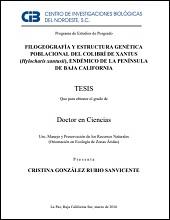Mostrar el registro sencillo del ítem
Filogeografía y estructura genética poblacional del colibrí de xantus (hylocharis xantusii), endémico de la península de Baja California
| dc.contributor | FRANCISCO JAVIER GARCIA DE LEON | |
| dc.contributor | RICARDO RODRIGUEZ ESTRELLA | |
| dc.creator | CRISTINA GONZALEZ RUBIO SANVICENTE | |
| dc.date | 2016-03-14 | |
| dc.identifier | http://cibnor.repositorioinstitucional.mx/jspui/handle/1001/53 | |
| dc.identifier.uri | http://dspace.cibnor.mx:8080/handle/123456789/2153 | |
| dc.description | La Península de Baja California (PBC), ha sido objeto de diversos estudios filogeográficos debido a su compleja historia geológica, climática, y topográfica. La principal señal observada son discontinuidades genéticas o estructura filogeográfica de múltiples taxa, donde la distribución de filogrupos, representa una evidencia del impacto de los eventos vicariantes ocurridos durante la formación y separación de la PBC. Sin embargo, algunos pocos trabajos han paleado hipótesis alternativas (e.g. fluctuaciones climáticas o eventos de dispersión), o han integrado distintas herramientas moleculares para comprender la influencia relativa de los procesos históricos antiguos y recientes, sobre los patrones de variación genética actual de las especies. Este estudio presenta la primera investigación sobre los patrones de diversidad genética y morfológica de la única especie de colibrí endémica de la PBC, el colibrí de Xantus (Hylocharis xantusii). Esta especie se distribuye desde la porción media de la PBC hasta los Cabos. En una muestra de 154 individuos se estudio la variación genética de tres genes del ADNmit (Cyt-b, COI y ND2; 2,297 pb), 16 microsatélites polimórficos especie-específicos, información climática obtenida de la modelación de nicho ecológico (MNE), y de las proyecciones al último interglacial (UIG) y último máximo glacial (UMG), así como la variación de seis rasgos morfológicos relacionados al dimorfismo sexual de la especie. El objetivo fue determinar las relaciones entre el patrón de variación genética y morfológica con los eventos históricos antiguos (geológicos) y recientes (fluctuaciones climáticas del Pleistoceno y la heterogeneidad ambiental). El análisis espacial de 56 haplotipos de ADNmit detectó tres poblaciones o linajes mitocondriales espacialmente diferenciados; uno en la región Norte (población D), otro en la porción Central (población C y B) y un último en la región Sur (población A). Las estimaciones de tiempos de divergencia entre los haplotipos mitocondriales de seis especies de colibríes apoyan la hipotésis de dos eventos vicariantes: 1) la separación permanente de la península hace 5 ma, y 2) el aislamiento temporal de la región del Cabo hace 3 ma. El marco temporal de diferenciación genética intraespecífico, indicó que el 90% de los linajes comenzaron a divergir en los últimos 500,000 años, con una expansión poblacional hace 80,000 años [...] | |
| dc.description | The Baja California Peninsula (BCP) has been the subject of study by a diverse research works on phylogeography, due to its complex topographic, geologic, and climatic history. The main signal encountered is genetic discontinuity or phylogeographic structure of multiple taxa, where the distribution of phylogroups, provides evidence of the impact of vicariant events during the formation and separation of the BCP. However, few studies have resorted to alternative hypothesis (e.g. climatic fluctuations or dispersal events), or have integrated different molecular tools for understanding the relative influence of ancient and recent historical processes have on current patterns of genetic variation in species. This study constitutes the first research about genetic diversity and morphologic patterns of the single endemic hummingbird species of the BCP, the Xantus´ hummingbird (Hylocharis xantusii). This species distributes from the middle portion of the BCP to Los Cabos. Using a sample of 154 individuals we studied the genetic variation of three genes mitDNA (Cyt-b, COI y ND2; 2,297bp), 16 polymorphic microsatellite species-specific, also climatic information obtained from the ecological niche modeling (ENM), Last Interglacial Predictions (LIG), and the Last Glacial Maximum (LGM), as well as the variation on six morphological traits linked to sexual dimorphism in the species. The aim was to determine the relationship between the morphologic and genetic variation patterns and ancient historical events (geologic) as well as recent historical processes (Pleistocene climatic fluctuations and environmental heterogeneity). The spatial analysis of 56 haplotypes of mitDNA showed there are three mitochondrial lineages or populations that could be spatially differentiated; the phylogeographic structure consisting of a North (population D), Central (population C and B) and South (population A) regions. The estimated divergence times obtained between the mitochondrial haplotypes of six hummingbird species supports the hypothesis of two vicariant events: 1) the permanent separation of the peninsula and formation of the Gulf of California at 5 mya, and 2) temporary isolation of the southern region at the Isthmus of La Paz at 3 mya. The temporal frame of genetic differentiation of intraspecific haplotypes indicates that 90% of haplotypes diverged within the last 500,000 years, with a population increase 80,000 years ago [...] | |
| dc.format | application/pdf | |
| dc.language | spa | |
| dc.publisher | Centro de Investigaciones Biológicas del Noroeste, S.C. | |
| dc.rights | info:eu-repo/semantics/openAccess | |
| dc.rights | http://creativecommons.org/licenses/by-nc-nd/4.0 | |
| dc.subject | info:eu-repo/classification/Autor/Hylocharis xantusii; Peninsula de Baja California; filogeografía; vicarianza; pleistoceno; heterogeneidad ambiental; dimorfismo morfológico | |
| dc.subject | info:eu-repo/classification/cti/2 | |
| dc.subject | info:eu-repo/classification/cti/24 | |
| dc.subject | info:eu-repo/classification/cti/2409 | |
| dc.subject | info:eu-repo/classification/cti/240903 | |
| dc.subject | info:eu-repo/classification/cti/240903 | |
| dc.title | Filogeografía y estructura genética poblacional del colibrí de xantus (hylocharis xantusii), endémico de la península de Baja California | |
| dc.type | info:eu-repo/semantics/doctoralThesis |


